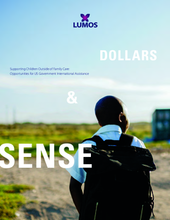To better understand the impact of donor funding, Lumos is conducting a five-part research study to examine the role of donors across a variety of sectors in propagating, supporting or ending the institutionalization of children. This report on US government funding is the first in the series.
US government assistance to vulnerable children in developing countries is channeled through more than 30 offices in seven US government departments and agencies working in over 100 countries. The US Government Action Plan on Children in Adversity (the Action Plan) provides a framework to guide the use of US government assistance to vulnerable children, and one of its main objectives is putting family care first and reducing the number of children in residential care. However, this report notes that some US government programs conflict with the Action Plan and other established child protection policy guidance. The Action Plan's sound policies and best practices in child safeguarding do not consistently trickle down to the field, and some US government funding is still used to prop up orphanages and other residential institutions abroad. As part of its report, Lumos offered recommendations to improve coordination and effectiveness of US government programming, which includes taking steps to: review legislative mandates concerning international assistance to vulnerable children and families to determine whether sufficient oversight and funding exists, current structures are effective, and interagency efforts are comprehensive, coordinated and achieving measurable results; ensure the high-level and consistent consideration of children’s rights, policies and programs in US government international assistance and diplomacy; ensure that each US government department, agency or office responsible for international assistance to children has a robust and consistently applied child protection policy, including field-level guidance for US government staff, contractors and grantees; and improve measurement and evaluation of program impact and ensure that US government agencies and departments supporting international assistance programs to vulnerable children report annually on clear and measurable indicators specified in the Action Plan.

